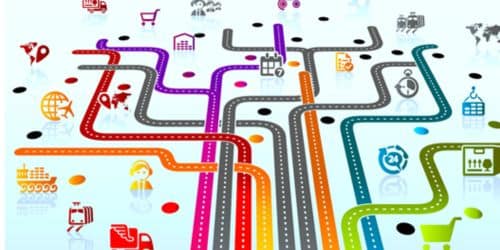Because it enables delivery to a wide range of recipients, distribution is one of the most critical components of a product-based firm. Choosing the best distribution model is a critical choice that can impact how your organization operates. A thorough understanding of direct versus indirect distribution can assist you in determining which distribution method is best for your company. In this post, we will look at direct distribution, how it works, and the benefits of using a direct distribution channel.
What Is Direct Distribution?
Direct distribution is a marketing approach in which a supplier or manufacturer provides things to the consumer directly. Because enterprises normally process and sell their own products, this method of distribution rarely involves the employment of wholesalers or other distributors. Because they may promote an item through their own website and in-store fliers, this method of distribution may also help businesses improve income and save on out-of-pocket fees for marketing agencies.
How Does Direct Distribution Work?
Direct distribution is a direct-to-consumer model. This usually necessitates the manufacturer’s or producer’s own transportation or logistical facilities. It also implies that they manage all distribution channels, which may include:
- Manufacturer
- Warehouse
- Shipping
- Retail
- Online
Many direct distribution models are online, which includes consumers placing orders through their company’s website. When a customer places an order, the company ships the goods directly to them. Another example of direct distribution is retail. For example, a customer walks inside a store, selects an item, and then walks out. Many parties may be involved in the process in various distribution models, such as indirect distribution. This may necessitate many sales channels and tight collaboration with third-party delivery providers.
The Benefits of Direct Distribution
- Direct distribution companies have complete control over how their product is marketed and sold. When you sell wholesale to a distribution agent or retailer, you allow them to promote, display, and deliver your products.
- Direct distribution enables firms to develop meaningful relationships with their product’s end users. Customers’ comments and product performance reviews can be addressed by businesses. Brands may establish customer loyalty and trust by connecting with them through direct-to-consumer fulfillment services.
- Consumers have grown used to quick and smooth digital experiences. A direct-to-consumer retail strategy ensures eCommerce client pleasure by facilitating the circulation of items for quick delivery. Indirect distribution via third parties might cause delivery delays.
- Companies that use direct distribution can avoid the high markups and costs involved with engaging intermediaries to distribute their products. Product profit margins are better for companies that sell directly to their customers.
- Companies do not have to worry about sharing “shelf space” off- and online when selling products directly to customers. Direct distribution allows businesses to differentiate themselves from the competition.
- One of the primary benefits of direct distribution is that it allows businesses to obtain important marketing data about their clients’ purchasing behaviors, demographics, and more.
The Cons Of Direct Distribution
- Companies that sell their products through direct distribution channels require warehouse management to manage storage space and inventory.
- Without various indirect distribution channels to broaden their reach, direct distribution shops may miss out on opportunities to capitalize on their items. Wholesalers and retailers understand their markets and specialize in product promotion.
- For business owners, direct distribution can be time-consuming and costly. Companies that distribute their own products are obliged to juggle multiple tasks at once, rather than focusing on the competency of their product and client relationships.
The Difference Between Direct And Indirect Distribution
#1. Process management
Consider the two distribution types’ distinct management processes. Manufacturers often manage various processes with direct distribution. They manage all of the procedures in between since they manufacture the goods and then deliver it directly to the consumer. Multiple organizations oversee a single process under the indirect distribution model. The distribution company has less influence over the other operations in an indirect approach, sometimes depending on third-party organizations to finish the delivery process.
#2. Resources required
The resources required for each distribution type are often varied. Direct distribution manufacturers may demand extra resources upfront, such as packaging material and shipping labels, because they oversee all stages of product delivery. This may increase the overall cost, but being able to provide the product directly to the customer may be more beneficial for a corporation because they receive direct payment. In comparison, because they focus on only one component of the manufacturing process, indirect distribution companies may require lower start-up expenses.
#3. Customer satisfaction
Understanding how each distribution type works can be beneficial when evaluating customer experience. The direct distribution strategy allows a company to interact more closely with a customer to provide the finest customer care possible. This enables them to satisfy the needs of customers based on product and delivery feedback. However, because they often manage a piece of the process that has little to do with shipping speeds or quality control, indirect distributors may have less control over the consumer experience.
What Is a Direct Distribution Channel?
Simply said, a distribution channel is the path a product takes from its original creator to the final consumer.
There is a lot of space for customization and multiple distribution routes here. Direct and indirect distribution routes exist. Direct channels, in general, have the shortest distance and are the simplest distribution channel. Many things have been more easier since the internet, and direct avenues of distribution have grown much more common in business.
Understanding The Direct Distribution Channel
Typically, a product will transit through a number of hands before reaching the consumer. A direct distribution channel is one that goes directly from the producer’s hands to the consumer’s hands. If the product must transit through numerous intermediaries before reaching the consumer’s hands, the route is considered an indirect channel of distribution.
Such direct chains may include a variety of sales. A sale could take place face to face, as in a farmer’s market, when farmers bring their produce to the market and sell directly to the purchasers who attend. It is also possible that the direct sale occurs on a computer, such as when you purchase directly from the manufacturer’s website, by mail order, or through virtually any other channel. The only thing that distinguishes that method as a direct distribution channel is that you interact directly with the producer; there are no middlemen involved. A chain of distribution cannot be labeled direct if it includes a wholesaler or retailer who is not linked with the original producer. It is an indirect distribution chain.
Direct Distribution Channel Forms
The most typical method we see this distribution channel being employed is by any organization that employs:
- Catalog sales: To sell their items, they create catalogs that can be distributed in paper or digital form, and the consumer selects their product, which is then delivered to their home.
- Television sales: In this situation, the product is advertised on television, followed by a phone number where the buyer may place his purchase and have it delivered to his home.
- Sales by mail: occur when a corporation contacts a consumer directly via email to market their items, take orders, and make the associated delivery. Many businesses use it nowadays.
- Home sales: This form summons persons who may be future customers of a product, shows them the product, and explains its use and benefits to them. Those who are interested can purchase their goods there.
In general, home sales are employed by any company that delivers its product directly to its customer.
These are the most prevalent modes of distribution, but there are many more that use the direct distribution channel.
Examples of Direct Distribution Channels
There are countless cases that fit this description. Here are a few examples:
#1. Door-to-Door Selling
This is one of the most traditional methods of product distribution. The producer may hire traveling salesmen who go out to the field and try to sell the goods to the consumer on the spot. If the product is portable enough, salespeople will bring it with them and try to sell it directly to customers. If the product cannot be transported by the salespeople, the producer must arrange for its delivery to the buyer as soon as the sale is completed.
Take, for example, a company that sells vacuum cleaners. It will open branches in every major consumer center and employ a sales team to sell vacuum cleaners door to door. When a customer agrees to purchase, the manufacturer arranges for their vacuum cleaner to be delivered from the nearest branch. If the company, on the other hand, sold simple kitchenware, the salesman might be able to carry them about and sell them straight to customers.
#2. Sales at Chain Stores
The larger manufacturing companies can afford to open proprietary retail locations in various regions, allowing their products to reach the consumer directly. There are several different scales here. We have the tiny producer with a single chain store in a single area all the way up to the larger producers with several retail stores across the globe.
#3. Sales by courier or post office
The post office method of sales is one of the oldest distribution channels, but it is still used today, as many companies distribute their items straight to the consumer using both couriers and the post office.
A chosen set of consumers may be sent sales literature by the company. The firm may also reach out to customers via email or social media. Customers can then place their orders either conventionally via mail, fax, phone, or online. The product will subsequently be delivered to the customer by the manufacturer by courier or value-paying post. This is the essence of a mail-order transaction.
#4. Sales by Telemarketing
In this strategy, the manufacturer will market their product on television, going into detail about the product’s features, price, usage, and availability. Customers that are interested can then place their orders via fax, email, or phone.
After that, the merchandise will be delivered via courier.
#5. Direct Online Selling
In some ways, this strategy supplants the other because the internet allows you to directly market to a large number of consumers without leaving your office or opening a retail store. Simply promote online, either through your own website, Google Ads, or social media. Your consumers can then place an order directly on your website or via email, and you will ship the items to them via post, courier, or your own cars.
Direct selling is the shortest and most straightforward mode of distribution. Direct selling allows you to get your goods to the buyer fast, ensuring their happiness.
You also get to cut out the middlemen and their markups, allowing your goods to reach consumers at significantly lower pricing. You can also contact customers directly and gain their faith in your brand.
Direct Distribution Channel Benefits
There are numerous benefits to employing a direct channel of distribution to get your goods to the consumer.
- When you employ a web-based channel, you may reach customers all over the world while keeping your overhead minimal.
- Because there are no middlemen, you can enjoy better profit margins on your products.
- If you opt to undertake online direct marketing, you present your consumers with a convenient service that is available 24 hours a day, seven days a week. Your clients will enjoy it.
- Many customers value the ability to deal directly with a product’s producer. Even if you’re an artist offering music or another sort of art, your clients would appreciate directly handing you the money. They will also become more acquainted with your brand, which will increase their loyalty.
Disadvantages of Direct Distribution Channels
There are a number of drawbacks to using direct routes of distribution that you should consider before using them for your items.
Indirect distribution has enormous global networks that include a large number of wholesalers and retailers. A direct distribution channel would struggle to compete with such a large network. You cannot readily sell as much of your product as you might with a broad distribution network.
Another downside of physical products offered through direct channels of distribution is that clients are frequently required to shoulder the shipping fees, which is inconvenient for them. The typical counterargument is that the products are likewise less expensive. When a buyer purchases a product from a middleman who offers free shipping, they tend to pay a higher price, making the product significantly more expensive than if they purchased the goods directly from the manufacturer and had already paid postage.
Why Is Direct Distribution Good?
Direct distribution enables firms to develop meaningful relationships with their product’s end users. Customers’ comments and product performance reviews can be addressed by businesses. Brands may establish customer loyalty and trust by connecting with them through direct to consumer fulfillment services.
Is Amazon Direct Distribution?
Yes. Amazon sells things directly to consumers through its website, and it also has a massive network of warehouses and fulfillment centers that allow it to transport products to customers all over the world swiftly.
What Are the Four Different Types of Distribution Channels?
Direct selling, selling through intermediaries, dual distribution, and reverse logistics channels are the four types of distribution channels.
Related Articles
- DIRECT VS INDIRECT DISTRIBUTION: What is the Difference?
- WHAT IS A BOARD OF DIRECTORS: Definition, Types & Roles
- Direct Selling: Examples, List, And Types.
- WHAT IS A DISTRIBUTION CHANNEL? Types and Examples






